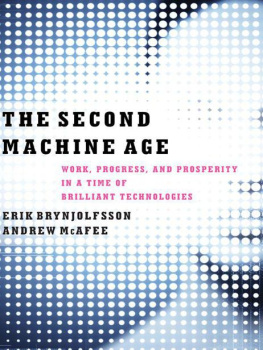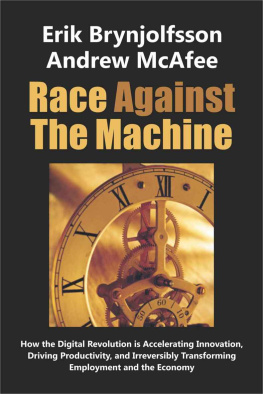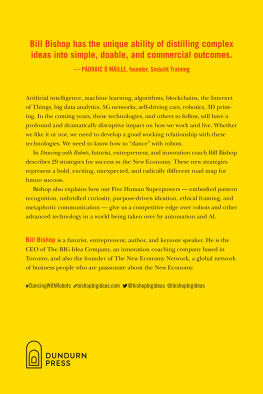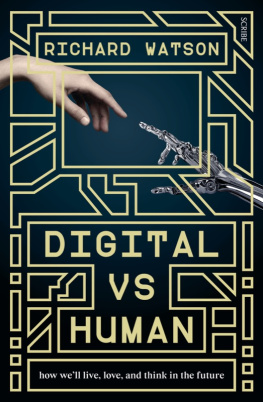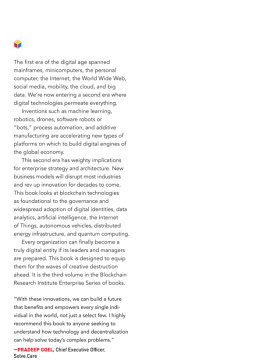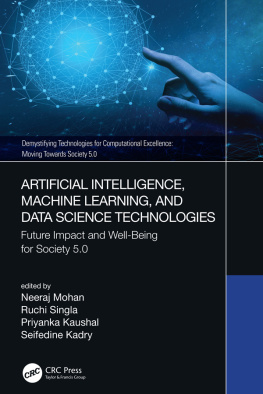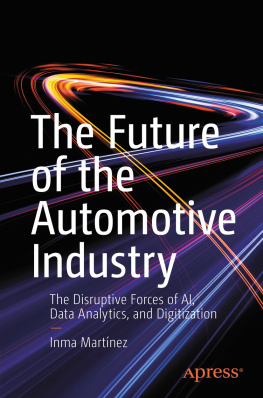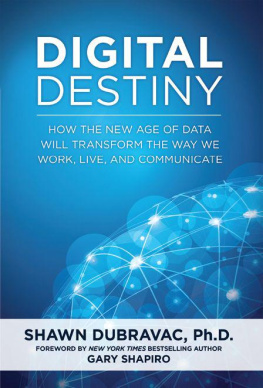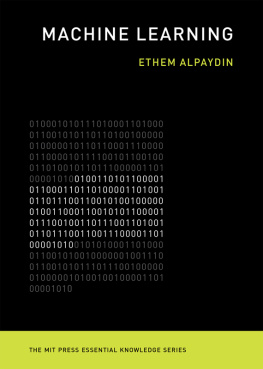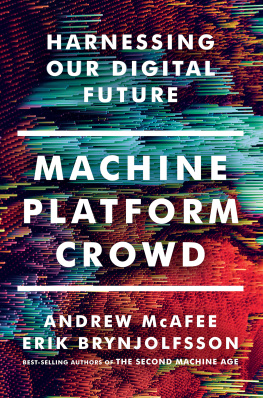Erik Brynjolfsson - The Second Machine Age: Work, Progress, and Prosperity in a Time of Brilliant Technologies
Here you can read online Erik Brynjolfsson - The Second Machine Age: Work, Progress, and Prosperity in a Time of Brilliant Technologies full text of the book (entire story) in english for free. Download pdf and epub, get meaning, cover and reviews about this ebook. year: 2014, publisher: W. W. Norton, genre: Romance novel. Description of the work, (preface) as well as reviews are available. Best literature library LitArk.com created for fans of good reading and offers a wide selection of genres:
Romance novel
Science fiction
Adventure
Detective
Science
History
Home and family
Prose
Art
Politics
Computer
Non-fiction
Religion
Business
Children
Humor
Choose a favorite category and find really read worthwhile books. Enjoy immersion in the world of imagination, feel the emotions of the characters or learn something new for yourself, make an fascinating discovery.
- Book:The Second Machine Age: Work, Progress, and Prosperity in a Time of Brilliant Technologies
- Author:
- Publisher:W. W. Norton
- Genre:
- Year:2014
- Rating:5 / 5
- Favourites:Add to favourites
- Your mark:
The Second Machine Age: Work, Progress, and Prosperity in a Time of Brilliant Technologies: summary, description and annotation
We offer to read an annotation, description, summary or preface (depends on what the author of the book "The Second Machine Age: Work, Progress, and Prosperity in a Time of Brilliant Technologies" wrote himself). If you haven't found the necessary information about the book — write in the comments, we will try to find it.
A New York Times Bestseller
A revolution is under way.
In recent years, Googles autonomous cars have logged thousands of miles on American highways and IBMs Watson trounced the best human Jeopardy! players. Digital technologieswith hardware, software, and networks at their corewill in the near future diagnose diseases more accurately than doctors can, apply enormous data sets to transform retailing, and accomplish many tasks once considered uniquely human.
In The Second Machine Age MITs Erik Brynjolfsson and Andrew McAfeetwo thinkers at the forefront of their fieldreveal the forces driving the reinvention of our lives and our economy. As the full impact of digital technologies is felt, we will realize immense bounty in the form of dazzling personal technology, advanced infrastructure, and near-boundless access to the cultural items that enrich our lives.
Amid this bounty will also be wrenching change. Professions of all kindsfrom lawyers to truck driverswill be forever upended. Companies will be forced to transform or die. Recent economic indicators reflect this shift: fewer people are working, and wages are falling even as productivity and profits soar.
Drawing on years of research and up-to-the-minute trends, Brynjolfsson and McAfee identify the best strategies for survival and offer a new path to prosperity. These include revamping education so that it prepares people for the next economy instead of the last one, designing new collaborations that pair brute processing power with human ingenuity, and embracing policies that make sense in a radically transformed landscape.
A fundamentally optimistic book, The Second Machine Age will alter how we think about issues of technological, societal, and economic progress.
ReviewFascinating. (Thomas L. Friedman - New York Times)
A terrific book. Brynjolfsson and McAfee combine their knowledge of rapidly evolving digital technologies and relevant economics to give us a colorful and accessible picture of dynamic forces that are shaping our lives, our work, and our economies. For those who want to learn to Race with the Machines, their book is a great place to start. (Michael Spence, winner of the 2001 Nobel Prize in Economic Sciences)
Erik and Andy have lived on the cutting edge, and now, with this book, they are taking us there with them. A brilliant look at the future that technology is bringing to our economic and social lives. Read The Second Machine Age if you want to prepare yourself and your children for the world of work ahead. (Zo Baird, president, Markle Foundation)
How we build, use, and live with our digital creations will define our success as a civilization in the twenty-first century. Will our new technologies lift us all up or leave more and more of us behind? The Second Machine Age is the essential guide to how and why that success will, or will not, be achieved. (Garry Kasparov, thirteenth World Chess Champion)
The Second Machine Age offers important insights into how digital technologies are transforming our economy, a process that has only just begun. Erik and Andrews thesis: As massive technological innovation radically reshapes our world, we need to develop new business models, new technologies, and new policies that amplify our human capabilities, so every person can stay economically viable in an age of increasing automation. I couldnt agree more. (Reid Hoffman, cofounder/chairman of LinkedIn and coauthor of the #1 New York Times bestseller The Start-up of You)
Although a few others have tried, The Second Machine Age truly helped me see the world of tomorrow through exponential rather than arithmetic lenses. Macro and microscopic frontiers now seem plausible, meaning that learners and teachers alike are in a perpetual mode of catching up with what is possible. It frames a future that is genuinely exciting! (Clayton M. Christensen, Kim B. Clark Professor of Business Administration, Harvard Business School, and author of The Innovators Dilemma)
Brynjolfsson and McAfee are right: we are on the cusp of a dramatically different world brought on by technology. The Second Machine Age is the book for anyone who wants to thrive in it. Ill encourage all of our entrepreneurs to read it, and hope their competitors dont. (Marc Andreessen, cofounder of Netscape and Andreessen Horowitz)
What globalization was to the economic debates of the late 20th century, technological change is to the early 21st century. Long after the financial crisis and great recession have receded, the issues raised in this important book will be central to our lives and our politics. (Lawrence H. Summers, Charles W. Eliot University Professor at Harvard University)
Technology is overturning the worlds economies, and The Second Machine Age is the best explanation of this revolution yet written. (Kevin Kelly, senior maverick for Wired and author of What Technology Wants)
Brynjolfsson and McAfee take us on a whirlwind tour of innovators and innovations around the world. But this isnt just casual sightseeing. Along the way, they describe how these technological wonders came to be, why they are important, and where they are headed. (Hal Varian, chief economist at Google)
In this optimistic book Brynjolfsson and McAfee clearly explain the bounty that awaits us from intelligent machines. But they argue that creating the bounty depends on finding ways to race with the machine rather than racing against the machine. That means people like me need to build machines that are easy to master and use. Ultimately, those who embrace the new technologies will be the ones who benefit most. (Rodney Brooks, chairman and CTO of Rethink Robotics, Inc)
New technologies may bring about our economic salvation or they may threaten our very livelihoodsor they may do both. Brynjolfsson and McAfee have written an important book on the technology-driven opportunities and challenges we all face in the next decade. Anyone who wants to understand how amazing new technologies are transforming our economy should start here. (Austan Goolsbee, professor of economics at the University of Chicago Booth School of Business and former chairman of the Council of Economic Advisers)
After reading this book, your world view will be flipped: youll see that collective intelligence will come not only from networked brains but also from massively connected and intelligent machines. In the near future, the best job to have will be the one you would do for free. (Nicholas Negroponte, cofounder of the MIT Media Lab, founder of One Laptop per Child, and author of Being Digital)
The Second Machine Age helps us all better understand the new age we are entering, an age in which by working with the machine we can unleash the full power of human ingenuity. This provocative book is both grounded and visionary, with highly approachable economic analyses that add depth to their vision. A must-read. (John Seely Brown, coauthor of The Power of Pull and A New Culture of Learning)
Brynjolfsson and McAfee do an amazing job of explaining the progression of technology, giving us a glimpse of the future, and explaining the economics of these advances. And they provide sound policy prescriptions. Their book could also have been titled Exponential Economics 101it is a must-read. (Vivek Wadhwa, director of research at Duke Universitys Pratt School of Engineering and author of The Immigrant Exodus)
Fascinating. (Andrew Leonard - Salon)
Maddeningly reasonable and readable. (Thomas Claburn - InformationWeek)
Excellent. (Clive Cook - Bloomberg)
Optimistic and intriguing. (Steven Pearlstein - The Washington Post)
About the AuthorErik Brynjolfsson is the director of the MIT Center for Digital Business and one of the most cited scholars in information systems and economics.
Andrew McAfee is a principal research scientist at the MIT Center for Digital Business and the author of Enterprise 2.0.
Subject : tech
Author : Brynjolfsson, Erik & McAfee, Andrew
ISBN : 9780393241259
Erik Brynjolfsson: author's other books
Who wrote The Second Machine Age: Work, Progress, and Prosperity in a Time of Brilliant Technologies? Find out the surname, the name of the author of the book and a list of all author's works by series.

